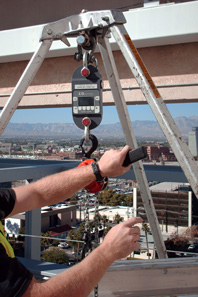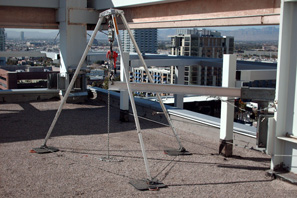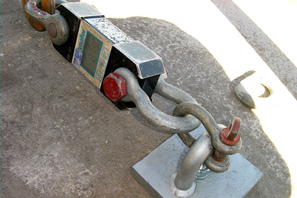
As building owners and managers have become increasingly mindful of the importance of maintaining their existing EBM / window cleaning equipment, the frequency and manner in which the equipment is tested has been the subject of much discussion. We have provided a brief overview of the testing requirements to help clarify many of the questions that our clients have about this issue.
As mandated by Federal OSHA, Part 1910.66(g) and California GISO Title 8, Para 3296, all EBM equipment and devices shall periodically be subjected to physical proof load testing. This procedure involves application of a percentage of the safe working load in a controlled manner using counterweights or a load binding device and is monitored with a calibrated dynamometer. A wide variety of techniques and configurations are utilized to accomplish this task in the safest, most efficient manner.
The scope of performing such tests is dependent on a number of factors. The most common cases have been outlined below:
Case #1:
In the case where the original design documents and calculations are not available for review, there can be no assurances that the equipment has been designed and installed properly, therefore inspectors will be unable to certify the equipment for use. In addition to a detailed review including a structural analysis by a professional engineer, an extensive load testing program will be required.
Case #2:
In the case where the design of the window cleaning equipment has been deemed deficient by the inspector or its engineer of record, the equipment will require modifications, and in some cases replacement. In addition to a detailed review including a structural analysis by a professional engineer, an extensive load testing program will be required following completion of the modifications and/or replacement.
Case #3:
In the case where the inspector has found that the condition of the window cleaning equipment to be questionable or damaged, the testing program will vary between moderate and extensive depending upon the specific conditions.
The frequency of performing proof load testing on appropriately designed and properly documented EBM systems is at the discretion of the inspector’s engineer of record, but it is typical to test equipment between 5 and 10 years depending on the equipment type. In addition to testing requirements for existing buildings, all new installations require proof load testing prior to issuance of a certification of safe use.
HighLine Consulting provides comprehensive load test prescriptions which allow our clients to compare bids for the testing work in a competitive format. In addition we provide professional oversight to ensure that the tests are administered and documented properly. Our prescriptions include detailed protocol which dictates the manner in which each element of the equipment shall be tested and documented as well as technical drawings which illustrate the method of testing. All of our documents are stamped by a Professional Engineer licensed in all 50 states.
Please contact us for further information about our Testing services.
Typical project scope may include testing of:
- Roof Tie-Back Anchors for Controlled Descent Apparatus (CDA a.k.a. Boatswain’s Chairs, Rope Descent Systems, RDS, Bosun’s Chairs)
- Roof Tie-Backs and Horizontal Lifeline (HLL) Systems for Fall Protection
- Counterweighted or Tied-Down Outrigger Beam Systems
- Standard and Flush Mounted Davit Pedestals
- Portable Roof Davit Arms
- Powered and Manual Monorail Track and Trolley Systems
- Gantries, Rigging Sleeves, Cornice Hooks, Parapet Clamps, and other misc. rigging
- Intermittent Stabilization Anchors (ISA) and other Sway Stabilization Systems
- Powered Platforms and Single Man Basket Systems
- Building Maintenance Unit (BMU) and Roofcar Systems

